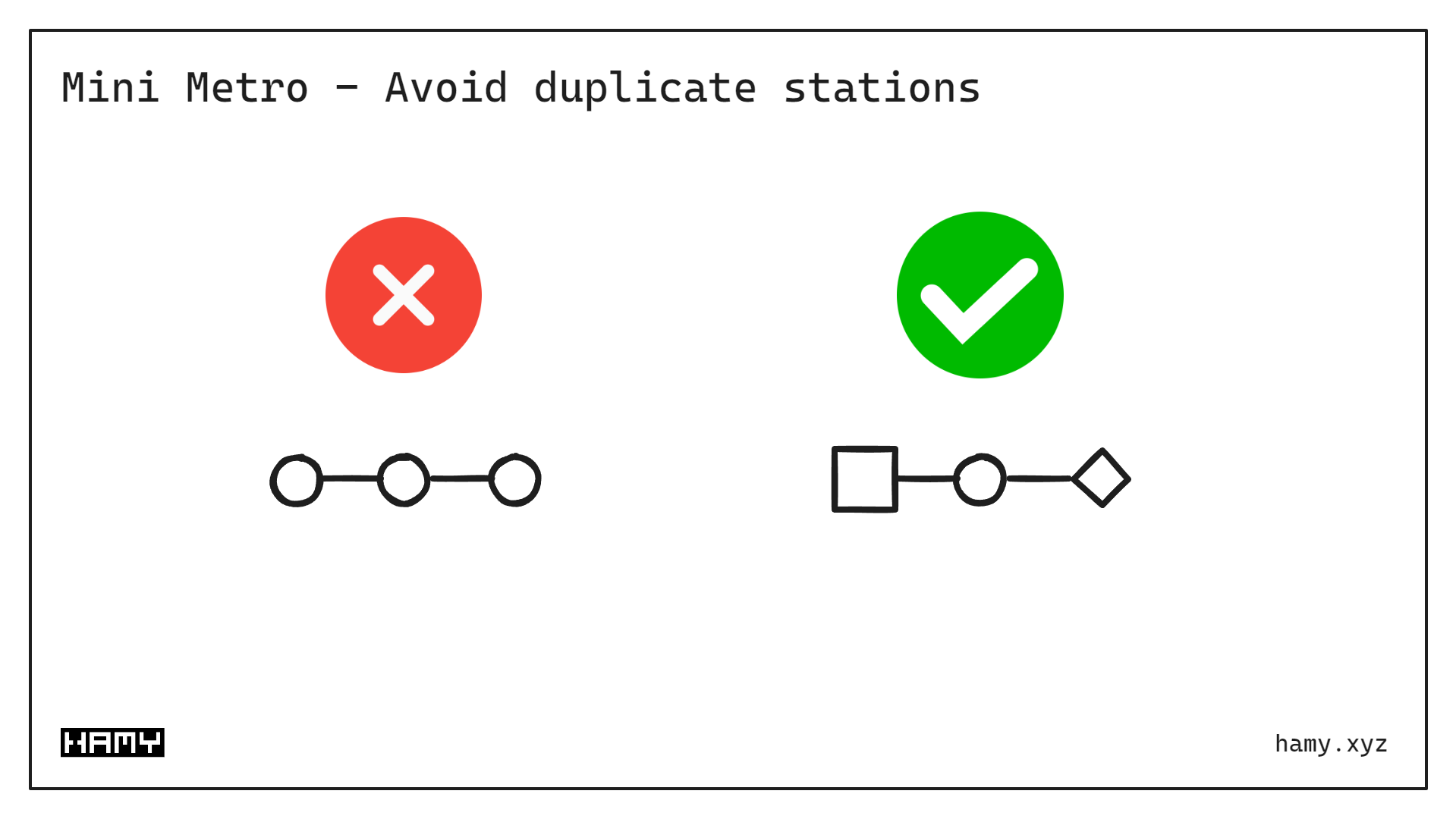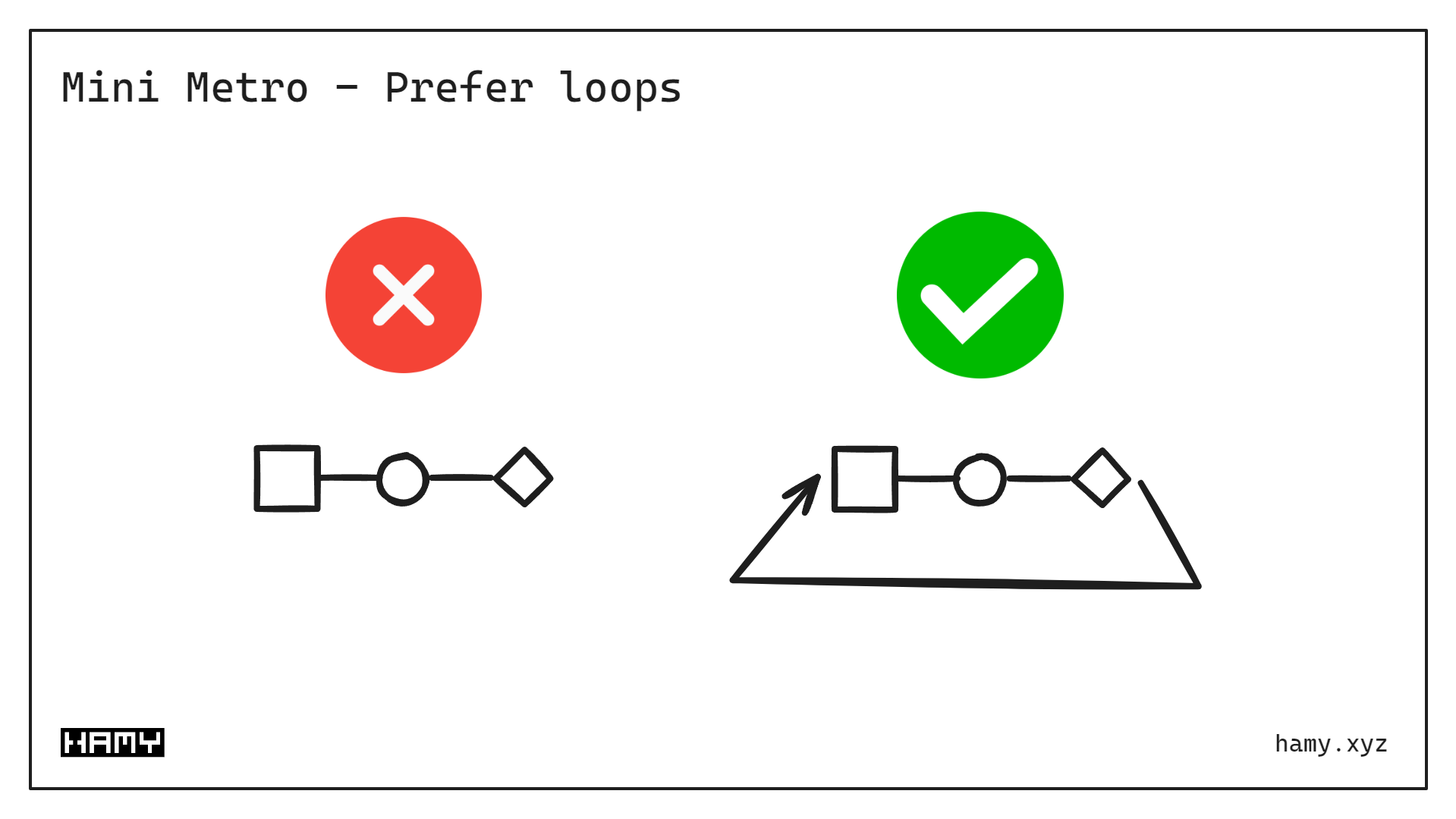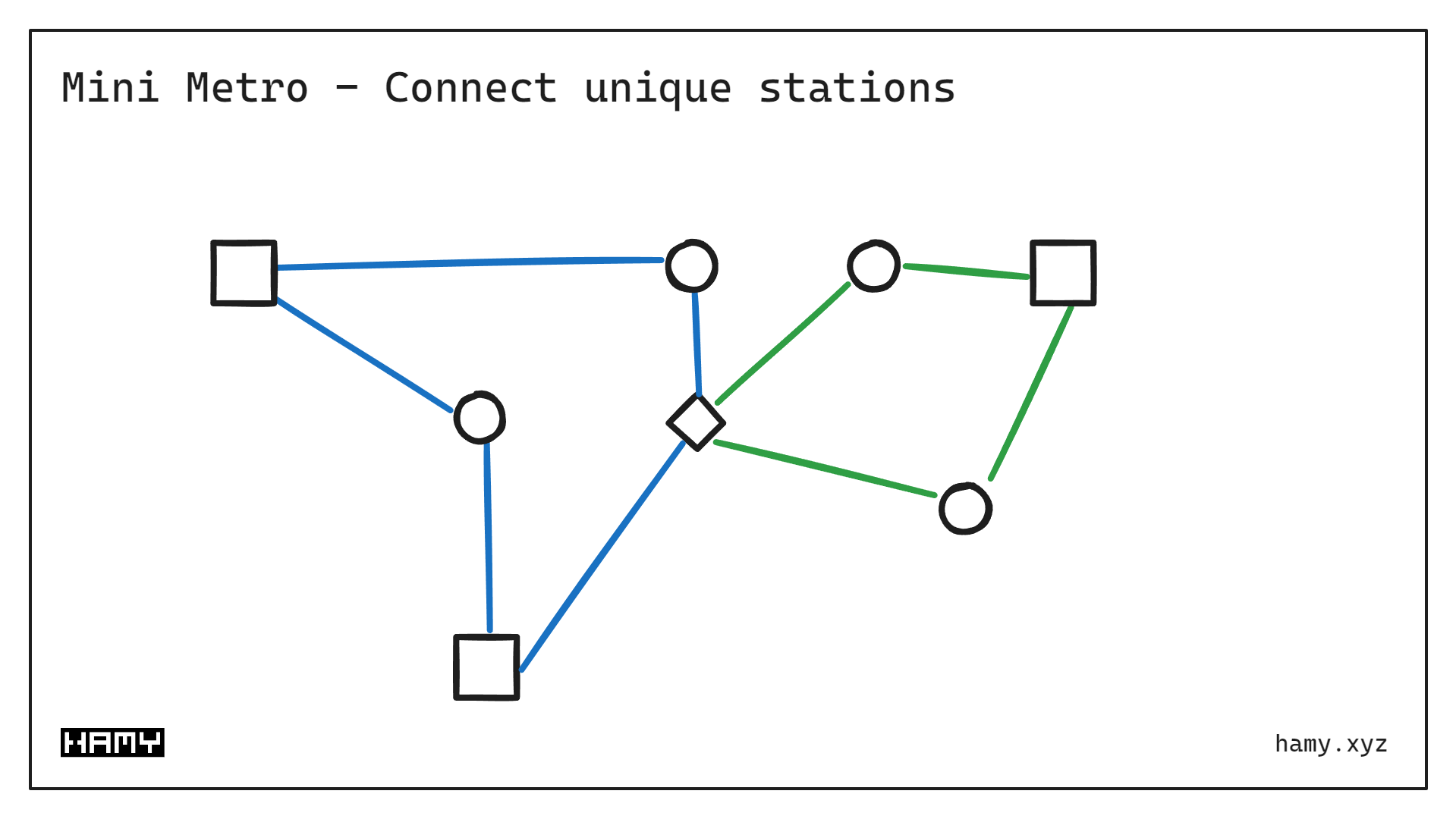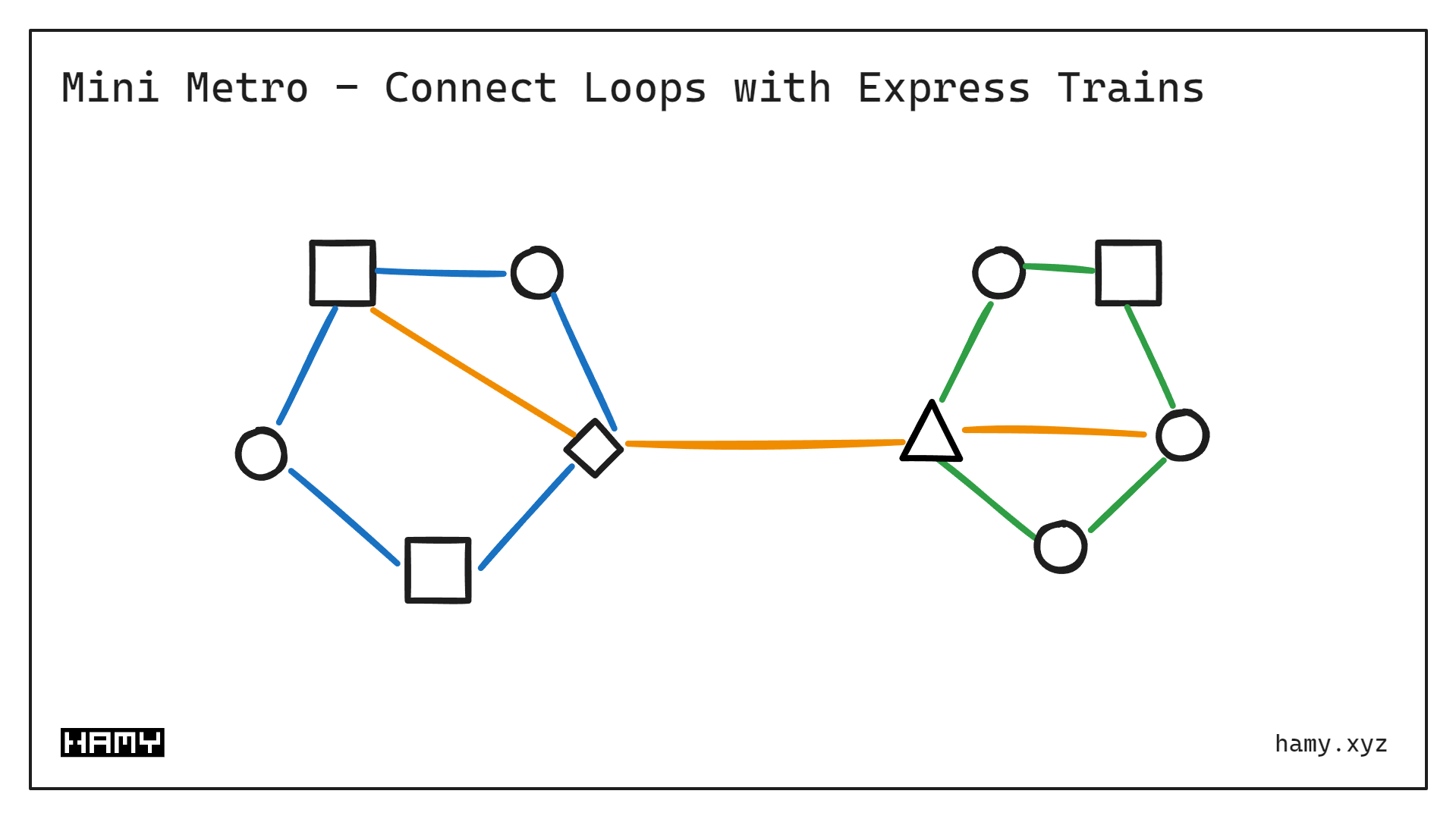Mini Metro - 5 Beginner Tips to Reach Top 10% on the Leaderboard
Date: 2024-03-25 | create | tech | video-games | mini-metro |
Mini Metro is a fun little optimization game. The mechanics are simple - move passengers through your subway system - but quickly ramps up complexity until your subway system falls apart.
Over time I've developed Simple Scalable Systems that have consistently placed my subway systems in the top 10% of each map so in this post I'm going to share tips so you can, too.
Avoid Duplicate Stations

The core optimization problem in Mini Metro is how to connect stations together such that you remove passengers from the system as fast as possible. The twist is that passengers can only leave the system on their target station shape.
We can model station shapes like:
- S - Square
- T - Triangle
- C - Circle
- Uniques - Star, Plus, Oval, etc
We know that passengers will never spawn on a station shape that matches their target. So connecting the same station shape multiple times effectively means these passengers can never leave the system for this part of the route.
So in general we want to avoid linking the same station shapes multiple times in a row - even if that means making your train line a little longer or a bit convoluted.
- 2 times in a row (CC) - Suboptimal but usually okay. As games go on this is inevitable.
- 3 times in a row (CCC) - Problematic and really try to avoid. This will cause backups and may sink your game.
- 4+ times in a row (CCCC+) - This is a game ender. Most games end because some section has this, is super inefficient, and takes resources away from rest of system.
Prefer loops to point-to-point lines

Most beginners draw point-to-point lines. This makes sense as it's how most real-world lines work. This works okay but it's unlikely you'll hit the top 10% (or even top 50%) if you only use point-to-point lines.
The problem with point-to-point lines is that they don't distribute train arrivals evenly across their line. This leads to regular starvation on each side of the line which leads to backups which is how games end.
Loops often help with this problem by forcing a regular cadence of arrivals across all stations they service. This often allows them to service more stations more efficiently thus freeing up resources to use in the rest of your system
Another benefit of loops is that every station shape is in "front" of the train. The pickup algorithm uses this to determine if a passenger should be picked up so this helps ensure passengers regularly get moved from station to station.
Prefer line connections on unique stations

Each map has its own probabilities for what station shapes will appear and each game is randomized so station shape and location will be slightly different. But what is true in every game is that some station shapes will be more common than others.
In general, the distribution of station shapes from most common to least common is:
- C - Circle
- T - Triangle
- S - Square
- Uniques - Star, Plus, Oval, etc - usually 1 on each map
More importantly - you should pay attention to the distribution of shapes in your game so you know what's most and least common.
The less common a station shape is, the harder it's going to be to get those passenger shapes out of the system. A good way to manage this is to connect multiple lines to the less common station shapes so that more lines are able to remove matching passengers with fewer transfers (thus faster).
Connect loops together with express trains

Towards the end of every game there will simply be too many passengers for your normal loops to efficiently remove them from the system. A common way to fix this is to connect loops with a new line we'll call express trains.
Express trains typically:
- Connect 2 or more loops
- Hit several uncommon station types to quickly remove passengers from system
- Often bisect loops (connects both sides of loop) to allow loops more places to leave hard-to-remove passengers
Use Ghost Lines Generously
Ghost Lines are an oft-overlooked gameplay mechanic that really sets most players apart from those climbing the leaderboard. It's so good that it feels like cheating so those who don't use it will almost always lose out to those who do.
A Ghost Line is a temporary line you put down to move passengers from A to B. The difference is that you immediately delete this line as soon as passengers at A are picked up.
This returns the line to your inventory but it also remains on the map to complete the trip to B. This is a Ghost line and enables quick, efficient movement from A to B allowing you to relieve pressure from backed up stations.
For games that end up in the top 10%, you'll be using Ghost Lines generously. In fact the latter half of the game will usually have most of your time devoted to Ghost Line management:
- Pause game
- Place Ghost Line
- Unpause game
- Pause game
- RM Ghost Line
- Place new Ghost Line
- Repeat
This makes games a lot longer but is remarkably effective at warding off game over conditions.
Bonus: Best Upgrades to Choose
Every Sunday you get an upgrade. Choosing the right upgrades is crucial for giving you the resources to build a top system.
The upgrade you should pick is heavily dependent on the current state of your system and its current / near-future bottlenecks. But generally some upgrades are better than others.
Here's how I prioritize upgrade choices:
- Carriage - Overall the best upgrade. It essentially gives you another train cars' worth of throughput. If you don't need anything else - choose this.
- Line - You will need lines to progress. I like to have 2 lines free (1 Ghost Line, 1 for expansion). If I don't have 2 lines free - I pick this to ensure I have flexibility to modify my system.
- Bridge / tunnel - I always want at least 1 for use in my Ghost Line. After that I try to have at least 2 extras if there's a section of the map across a river I'll need to connect.
- Interchanges - Basically never. It doesn't help to improve throughput or efficiency so better off picking a different one.
Next
Hopefully these Mini Metro tips help you improve your own systems. Remember that every game is different so sometimes you'll just get some bad shapes / locations. That's okay - games are short so worth another try.
If you liked this video you might also like:
Want more like this?
The best / easiest way to support my work is by subscribing for future updates and sharing with your network.